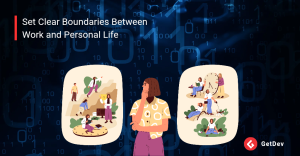
In the fast-paced world of technology, where deadlines are tight, innovation is constant, and the pressure to perform can be relentless, achieving a harmonious work-life balance often feels like chasing a mirage. This challenge is especially pronounced for tech professionals, newcomers to the tech industry, and passionate tech enthusiasts across Africa, where the digital landscape is evolving at a breakneck pace, and the demands of the industry continue to grow rapidly.
Yet, maintaining a healthy work-life balance is far more than just an aspirational goal, it’s an essential foundation for sustained success, productivity, and personal well-being. In this in-depth guide, we’ll delve into practical, actionable strategies designed to help navigate the unique challenges and harness the emerging opportunities faced by tech professionals throughout Africa.
Understanding the Work-Life Balance Conundrum in Tech
Before delving into practical strategies, it’s important to first understand the specific and often complex challenges that tech professionals in Africa face when it comes to maintaining a healthy work-life balance:
- Extended Work Hours: The tech industry frequently demands long and unpredictable hours, driven by tight project deadlines, high performance expectations, and the constant push to stay ahead of the curve. Over time, this can lead to chronic fatigue and burnout if not managed effectively.
- Remote Work Challenges: While remote work has opened up new opportunities and flexibility, it also presents its own set of difficulties. The lack of clear boundaries between professional responsibilities and personal life can make it increasingly difficult to fully disconnect and recharge.
- Cultural Expectations: In many African societies, there is a deep-rooted cultural emphasis on diligence, resilience, and commitment to one’s work. While these values drive excellence, they can sometimes unintentionally encourage sacrificing personal time and rest in pursuit of success.
- Limited Access to Mental Health Resources: Mental health support, including counseling and wellness programs, is still not widely accessible in many parts of Africa. This makes it more challenging for tech professionals to effectively cope with stress, anxiety, and the emotional toll of demanding workloads.
Recognizing and acknowledging these unique challenges is a critical first step toward implementing realistic and sustainable strategies to achieve better work-life balance in the tech space.
1. Set Clear Boundaries Between Work and Personal Life
Establishing and maintaining clear boundaries is essential for achieving a sustainable work-life balance, especially in the dynamic world of tech. Here’s how you can put this into practice:

- Define Work Hours: Set specific start and end times for your workday, and make a conscious effort to adhere to them consistently. Communicate these hours clearly with your colleagues, supervisors, and even family members, so everyone understands and respects your availability.
- Create a Dedicated Workspace: If you’re working remotely, carve out a specific area in your home that is solely for work. This physical separation not only helps create a mental distinction between work and personal life but also boosts focus and productivity during work hours, while making it easier to relax afterward.
- Use Technology Wisely: Make the most of digital tools like calendar and scheduling apps to organize both your work tasks and personal time. Set reminders to take breaks, schedule downtime, and block off personal hours so that work commitments don’t spill over into your time for rest, family, or self-care.
2. Prioritize Self-Care and Regular Breaks
Taking care of both your physical and mental well-being is not a luxury, it’s a necessity for maintaining long-term productivity, creativity, and resilience in the demanding tech industry. Here are some practical ways to make self-care a consistent part of your routine:

- Schedule Regular Breaks: Build short, intentional breaks into your daily schedule to help you rest, reset, and maintain focus. Techniques like the Pomodoro Technique, which involves working in focused intervals followed by short breaks, can enhance your efficiency while preventing mental fatigue.
- Engage in Physical Activity: Incorporate regular movement into your day, whether it’s a morning workout, a brisk 30-minute walk, or simple stretching exercises at your desk. Physical activity not only boosts your energy levels and mood but also helps combat the sedentary lifestyle that often accompanies tech work.
- Practice Mindfulness: Introduce mindfulness practices into your routine to stay grounded and reduce stress. Activities such as meditation, deep breathing exercises, or even journaling can help clear your mind, improve emotional regulation, and increase overall mental clarity.
3. Leverage AI Tools for Time Management
In today’s tech-driven world, Artificial Intelligence (AI) can be a powerful ally in helping you manage your time more efficiently and boost your productivity. By integrating the right tools into your workflow, you can streamline tasks, reduce distractions, and make better use of your day. Here’s how:

- Smart Scheduling: AI-powered scheduling tools, such as Calendar.AI, can learn your habits and preferences over time, automatically organizing meetings and appointments at times that align with your availability and peak productivity periods. This eliminates the back-and-forth of scheduling and ensures your calendar stays optimized.
- Productivity Tracking: Platforms like RescueTime or Toggl utilize AI to monitor how you spend your time across various tasks and applications. These insights allow you to identify patterns, eliminate inefficiencies, and adjust your routine to focus on high-value activities that align with your goals.
- Focus Assistance: Apps like Forest or Focus@Will use intelligent algorithms to help you maintain concentration by minimizing digital distractions. Whether it’s through ambient music tailored to your brainwaves or gamified time-blocking techniques, these tools can significantly enhance your ability to stay on task and in the zone.
4. Delegate Tasks and Learn to Say No
In the fast-paced tech world, it’s tempting to take on every task that comes your way but doing so can quickly lead to overwhelm and burnout. Developing the ability to delegate effectively and set boundaries by saying no is a critical skill for maintaining work-life balance and staying focused on what truly matters.

- Delegate Effectively: Take time to identify tasks that don’t require your direct involvement and can be handled by others on your team. Delegating not only helps lighten your workload but also fosters collaboration and empowers others to grow and take ownership of responsibilities.
- Set Priorities: Evaluate your workload regularly and focus on tasks that align with your personal and professional goals. It’s perfectly acceptable—and often necessary—to say no to projects or commitments that don’t serve your broader objectives. Prioritizing in this way ensures your energy is spent where it has the most impact.
- Use Project Management Tools: Leverage project management platforms such as Trello, Asana, or Monday.com to organize, assign, and track tasks with clarity. These tools help streamline collaboration, ensure accountability, and make it easier to delegate without losing visibility over progress.
5. Embrace Flexible Work Arrangements
Adopting flexible work arrangements can make a meaningful difference in promoting a healthier work-life balance, especially in the fast-evolving tech industry. By allowing professionals to adapt their work schedules and environments to fit their personal needs, flexibility fosters both productivity and well-being.

- Flextime: Introducing flexible working hours gives individuals the ability to adjust their start and end times based on their personal commitments and peak productivity periods. This autonomy can help reduce stress, improve focus, and support a more balanced daily routine.
- Remote Work Options: Providing the option to work remotely empowers employees to better manage their professional responsibilities alongside family, health, or community obligations. Whether full-time or hybrid, remote work arrangements can enhance satisfaction and reduce commuting-related fatigue.
- Results-Oriented Work Environment: Shift the focus from strict processes and hours to outcomes and deliverables. By measuring success based on results rather than how or when the work is done, you create a culture of trust and accountability, allowing team members to work in the ways that suit them best.
6. Foster a Supportive Work Culture
Creating and nurturing a supportive work environment is essential for promoting lasting work-life balance. When employees feel valued, heard, and supported, they are more likely to thrive both personally and professionally. Here’s how to cultivate such a culture:

- Open Communication: Encourage transparent and ongoing dialogue about workload, mental health, and work-life balance. By creating a safe space where team members can express concerns or share challenges without fear of judgment, leaders can build trust and address issues proactively.
- Provide Resources: Make support services readily available to your team. This could include access to professional counseling, mental health days, wellness programs, or stress management workshops. Offering these resources shows that the organization prioritizes employee well-being.
- Recognize Achievements: Regularly acknowledge and celebrate both individual and team accomplishments. Recognition, whether through public praise, small rewards, or professional development opportunities boosts morale, fosters motivation, and reinforces a positive, balanced workplace culture.
7. Continuous Learning and Adaptation

In the ever-changing landscape of the tech industry, maintaining work-life balance isn’t a one-time achievement, it’s an ongoing process that requires continuous learning and a willingness to adapt. Staying agile in your approach ensures you can respond effectively to new challenges and opportunities as they arise.
- Stay Informed: Regularly explore new tools, apps, and methods that can enhance your productivity and time management. Whether it’s an emerging AI platform, a new workflow technique, or research on workplace wellness, staying informed helps you make smarter, more efficient choices.
- Seek Feedback: Make it a habit to seek input from your colleagues, mentors, or supervisors. Constructive feedback can offer valuable insights into your work habits and highlight areas where small adjustments could significantly improve your balance and overall effectiveness.
- Adapt Strategies: Understand that your needs and circumstances will evolve over time. Be open to reassessing your approach to work-life balance and willing to revise your strategies to reflect changes in your work environment, career stage, or personal life. Flexibility and self-awareness are key to sustaining long-term well-being.
Conclusion
Achieving Harmony in the Tech World
Maintaining work-life balance as a tech professional in Africa is not just a personal ambition, it’s a strategic necessity in an industry that is constantly evolving and often demanding. As digital transformation accelerates across the continent, tech professionals face increasing pressure to deliver, adapt, and innovate. Amid this momentum, it becomes even more important to prioritize personal well-being, set boundaries, and embrace strategies that support long-term sustainability.
From leveraging AI tools for smarter time management to fostering a supportive work culture, each step outlined in this guide is designed to help you take control of your schedule, protect your mental health, and create space for rest, growth, and meaningful personal experiences. Work-life balance isn’t about achieving perfection, it’s about making intentional choices, staying adaptable, and recognizing that your well-being is the foundation of your professional success.
By embracing these practices, tech professionals across Africa can not only thrive in their careers but also lead more fulfilling, balanced lives. Harmony in the tech world is possible and it starts with you.